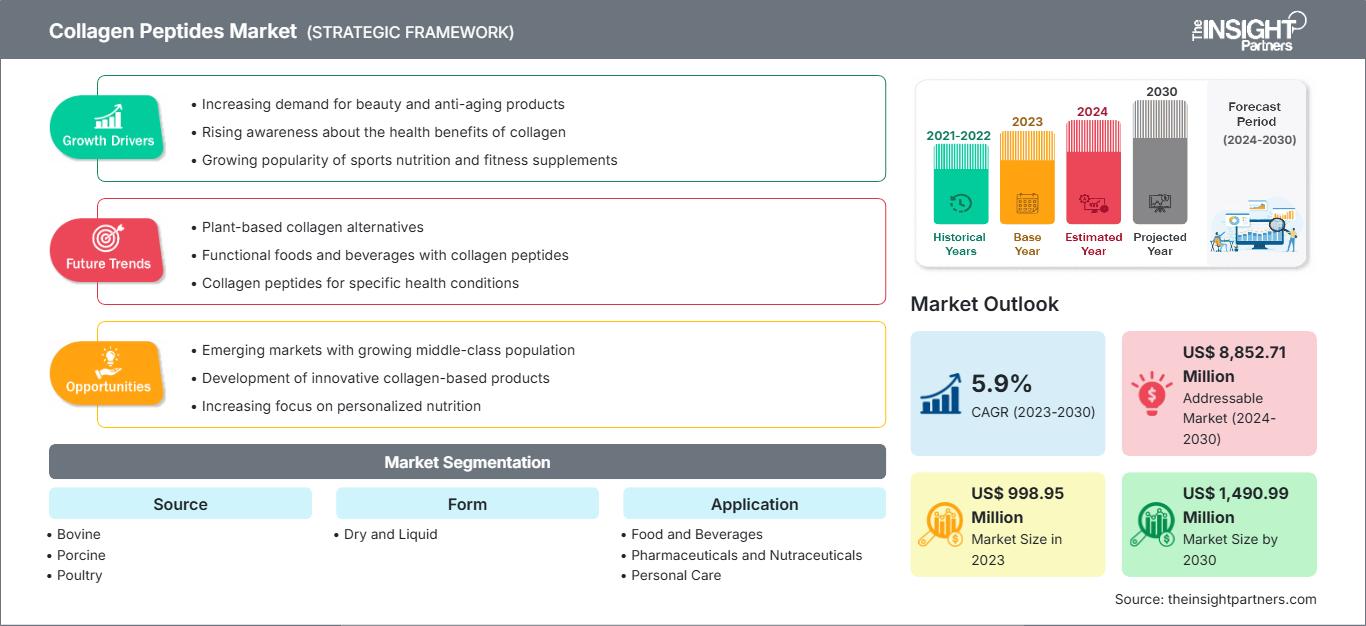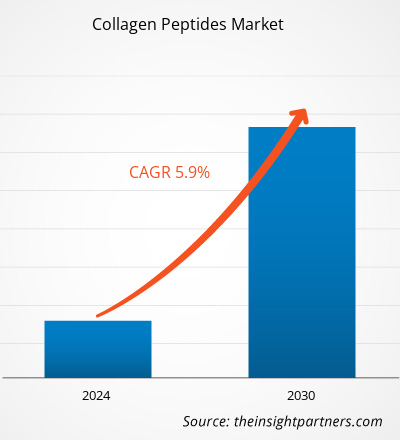[Informe de investigación] El mercado de péptidos de colágeno se valoró en US$ 998,95 millones en 2023 y se proyecta que alcance los US$ 1.490,99 millones para 2030; se espera que registre una CAGR del 5,9% de 2023 a 2030.
El mercado global de péptidos de colágeno es altamente competitivo, con un gran número de fabricantes locales, regionales e internacionales que compiten en función de la calidad y la innovación de sus productos. Algunos fabricantes de péptidos de colágeno han recibido certificaciones kosher y halal, lo que ha fortalecido su posición competitiva en el mercado global. Por ejemplo, Rousselot, uno de los principales fabricantes de colágeno, cuenta con unidades de producción con certificación halal y kosher. Además, la empresa también ha recibido las certificaciones IFS, ISO 9001, GMP+ y FCA, lo que ha fortalecido su posición en el mercado. Los fabricantes también invierten en innovación y desarrollo de nuevos productos para satisfacer las cambiantes preferencias de los clientes. Por ejemplo, Evonik Industries Inc. ha lanzado recientemente colágeno apto para veganos mediante un proceso de fermentación. Se espera que esta iniciativa ofrezca oportunidades lucrativas a los fabricantes en el mercado global de péptidos de colágeno.
En 2022, América del Norte representó la mayor participación en el mercado mundial de péptidos de colágeno, y se estima que Asia Pacífico registrará la tasa de crecimiento anual compuesta (TCAC) más alta durante el período de pronóstico. El péptido de colágeno se utiliza en diversos formatos de suplementos, como polvos, cápsulas, tabletas y gomitas, entre otros. La alta demanda de nutracéuticos en la región impulsa considerablemente las ventas de péptidos de colágeno. Por lo tanto, la industria nutricosmética incorpora cada vez más péptidos de colágeno para satisfacer las necesidades de los consumidores. Además, el péptido de colágeno es eficaz en la atrofia ósea, la pérdida de densidad ósea y la estabilidad ósea. Por lo tanto, su amplio espectro de aplicación impulsa la demanda de péptidos de colágeno en toda la región.
Personalice este informe según sus necesidades
Obtendrá personalización en cualquier informe, sin cargo, incluidas partes de este informe o análisis a nivel de país, paquete de datos de Excel, así como también grandes ofertas y descuentos para empresas emergentes y universidades.
Mercado de péptidos de colágeno: perspectivas estratégicas

-
Obtenga las principales tendencias clave del mercado de este informe.Esta muestra GRATUITA incluirá análisis de datos, desde tendencias del mercado hasta estimaciones y pronósticos.
Impacto de la pandemia de COVID-19 en el mercado de péptidos de colágeno
El creciente consumo de alimentos y bebidas funcionales, suplementos dietéticos y la alta demanda de productos ricos en proteínas son los factores clave que impulsaron el crecimiento del mercado de péptidos de colágeno antes del inicio de la pandemia de COVID-19. Sin embargo, estas industrias se enfrentaron a desafíos sin precedentes tras el brote de 2020.
En 2021, varias economías reanudaron sus operaciones tras el anuncio de los gobiernos de varios países de una flexibilización de las restricciones impuestas previamente, lo que impulsó el mercado global. Además, se permitió a los fabricantes operar a plena capacidad, lo que les ayudó a superar la brecha de oferta y demanda, así como otras repercusiones. Dado que numerosos ciudadanos de muchos países ya estaban completamente vacunados en 2021, los fabricantes de péptidos de colágeno se centraron en aumentar su producción para reactivar sus negocios.
Perspectivas del mercado
La creciente demanda de péptidos de colágeno de origen marino impulsará el crecimiento del mercado de péptidos de colágeno.
Los organismos marinos, como peces, medusas, esponjas y otros invertebrados, albergan una fuente importante de péptidos de colágeno. Presentan grandes ventajas respecto a otras fuentes, ya que son metabólicamente compatibles, carecen de restricciones religiosas y están libres de patógenos animales. Además, los péptidos de colágeno de origen marino pueden utilizarse como biomaterial gracias a su solubilidad en agua y compatibilidad metabólica. Por lo tanto, la demanda de péptidos de colágeno de origen marino está aumentando con su creciente utilización en diversas aplicaciones industriales.
Además, los péptidos de colágeno de origen marino no favorecen la transmisión de enfermedades. Los animales terrestres son portadores de numerosas enfermedades transmisibles, lo que los hace menos favorables para su uso industrial. Por ejemplo, el ganado vacuno, aunque es una gran fuente de colágeno, presenta riesgos de EEB y EEB. Estos factores hacen que las fuentes marinas de péptidos de colágeno sean una alternativa mucho más sencilla, segura y prometedora. Por ello, ante la creciente demanda, los fabricantes están lanzando diferentes productos. Por ejemplo, en enero de 2021, Darling Ingredients presentó Peptan, un péptido de colágeno marino bajo su marca Rousselot. Este producto ayuda a la empresa a entrar en el mercado de los suplementos dietéticos. Por lo tanto, se espera que la creciente demanda de colágeno de origen marino abra nuevas oportunidades en el mercado de los péptidos de colágeno durante el período de pronóstico.
Perspectivas basadas en fuentes
Según la fuente, el mercado de péptidos de colágeno se divide en bovino, porcino, avícola, marino y otros. El segmento bovino tuvo la mayor participación de mercado en 2022, mientras que el segmento marino registró el crecimiento más rápido durante el período de pronóstico. Los péptidos de colágeno marino se obtienen principalmente de diferentes variedades de peces, medusas y esponjas. Por lo tanto, la demanda de péptidos de colágeno de origen marino está aumentando como sustituto del bovino y el porcino, lo que se prevé que impacte el crecimiento del mercado de péptidos de colágeno.
Perspectivas basadas en aplicaciones
Según su aplicación, el mercado de péptidos de colágeno se segmenta en alimentos y bebidas, productos farmacéuticos y nutracéuticos, cuidado personal y otros. Se espera que este segmento registre la mayor tasa de crecimiento anual compuesta (TCAC) durante el período de pronóstico. En productos lácteos, se utiliza como agente texturizante y estabilizador. Los hidrolizados de colágeno pueden fijar iones de calcio, mejorando su biodisponibilidad. Por lo tanto, los péptidos de colágeno pueden utilizarse en ingredientes alimentarios funcionales para gestionar deficiencias minerales.
Los péptidos de colágeno pueden ser beneficiosos para alimentos que requieren almacenamiento en frío o congelación, ya que actúan como anticoagulantes y ayudan a disminuir el daño celular y tisular. Además, ayudan a mejorar y mantener las propiedades sensoriales, físicas y químicas del producto. Por ello, gracias a estas propiedades, se han utilizado en la preparación de diversos productos, como carnes, bebidas y sopas.
Las principales empresas del mercado de péptidos de colágeno son GELITA AG, Rousselot BV, Titan Biotech Ltd, Tessenderlo Group NV, Ewald-Gelatine GmbH, BioCell Technology LLC, Lapi Gelatine SpA, Weishardt Holding SA, Nippi Collagen NA Inc y Nitta Gelatin India Ltd. Estas empresas se centran en el lanzamiento de nuevos productos y la expansión geográfica para satisfacer la creciente demanda mundial y ampliar su gama de productos especializados. Su amplia presencia global les permite atender a una amplia cartera de clientes y, en consecuencia, aumentar su cuota de mercado.
Perspectivas regionales del mercado de péptidos de colágeno
Los analistas de The Insight Partners han explicado detalladamente las tendencias regionales y los factores que influyen en el mercado de péptidos de colágeno durante el período de pronóstico. Esta sección también analiza los segmentos y la geografía del mercado de péptidos de colágeno en América del Norte, Europa, Asia Pacífico, Oriente Medio y África, y América del Sur y Central.
Alcance del informe de mercado de péptidos de colágeno
| Atributo del informe | Detalles |
|---|---|
| Tamaño del mercado en 2023 | US$ 998,95 millones |
| Tamaño del mercado en 2030 | US$ 1.490,99 millones |
| CAGR global (2023-2030) | 5,9% |
| Datos históricos | 2021-2022 |
| Período de pronóstico | 2024-2030 |
| Segmentos cubiertos |
Por fuente
|
| Regiones y países cubiertos |
América del norte
|
| Líderes del mercado y perfiles de empresas clave |
|
Densidad de actores del mercado de péptidos de colágeno: comprensión de su impacto en la dinámica empresarial
El mercado de péptidos de colágeno está creciendo rápidamente, impulsado por la creciente demanda del usuario final debido a factores como la evolución de las preferencias de los consumidores, los avances tecnológicos y un mayor conocimiento de los beneficios del producto. A medida que aumenta la demanda, las empresas amplían su oferta, innovan para satisfacer las necesidades de los consumidores y aprovechan las tendencias emergentes, lo que impulsa aún más el crecimiento del mercado.

- Obtenga una descripción general de los principales actores clave del mercado de péptidos de colágeno
Informe destacado
- Tendencias progresivas de la industria en el mercado de péptidos de colágeno para ayudar a las empresas a desarrollar estrategias efectivas a largo plazo.
- Estrategias de crecimiento empresarial adoptadas por los actores del mercado en países desarrollados y en desarrollo
- Análisis cuantitativo del mercado de 2022 a 2030
- Estimación de la demanda mundial de péptidos de colágeno
- Análisis de las cinco fuerzas de Porter para ilustrar la eficacia de los compradores y proveedores en el mercado de péptidos de colágeno
- Desarrollos recientes para comprender el escenario del mercado competitivo
- Tendencias y perspectivas del mercado, impulsores y restricciones del crecimiento en el mercado de péptidos de colágeno
- Asistencia en el proceso de toma de decisiones destacando las estrategias de mercado que sustentan el interés comercial.
- Tamaño del mercado de péptidos de colágeno en varios nodos
- Una descripción detallada y dinámica de la industria de los péptidos de colágeno
- Tamaño del mercado de péptidos de colágeno en diversas regiones con prometedoras oportunidades de crecimiento
- Análisis histórico (2 años), año base, pronóstico (7 años) con CAGR
- Análisis PEST y FODA
- Tamaño del mercado, valor/volumen: global, regional y nacional
- Industria y panorama competitivo
- Conjunto de datos de Excel
Informes recientes
Testimonios
Razón para comprar
- Toma de decisiones informada
- Comprensión de la dinámica del mercado
- Análisis competitivo
- Información sobre clientes
- Pronósticos del mercado
- Mitigación de riesgos
- Planificación estratégica
- Justificación de la inversión
- Identificación de mercados emergentes
- Mejora de las estrategias de marketing
- Impulso de la eficiencia operativa
- Alineación con las tendencias regulatorias






















 Obtenga una muestra gratuita para - Mercado de péptidos de colágeno
Obtenga una muestra gratuita para - Mercado de péptidos de colágeno